ACC00724: In-depth Financial Analysis of Bega Cheese Ltd (BGA)
VerifiedAdded on 2023/06/10
|15
|2669
|297
Report
AI Summary
This report presents a comprehensive financial analysis of Bega Cheese Ltd, covering the period from 2013 to 2017. It includes a horizontal analysis of the income statement, highlighting trends in revenue, cost of sales, and profitability. The analysis reveals consistent revenue growth and improved cost management. Key financial ratios, such as return on assets, return on equity, and profit margins, are computed and analyzed to assess the company's operational efficiency, liquidity, and capital structure. The report also discusses the implications of these ratios for the company's financial health and future performance, with a focus on improvements in liquidity and profitability over the analyzed period. The assignment is based on ACC00724 Accounting for Managers course.
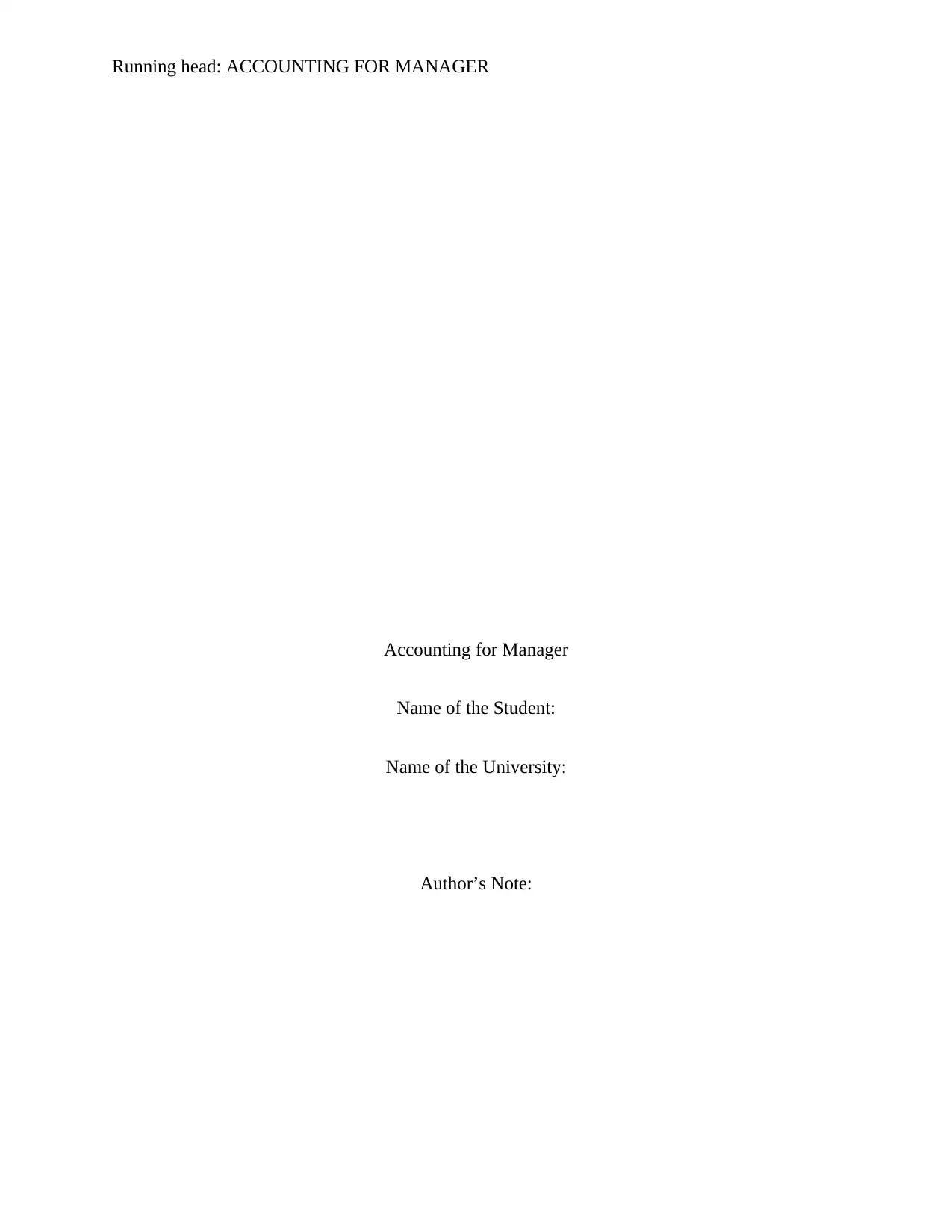
Running head: ACCOUNTING FOR MANAGER
Accounting for Manager
Name of the Student:
Name of the University:
Author’s Note:
Accounting for Manager
Name of the Student:
Name of the University:
Author’s Note:
Paraphrase This Document
Need a fresh take? Get an instant paraphrase of this document with our AI Paraphraser
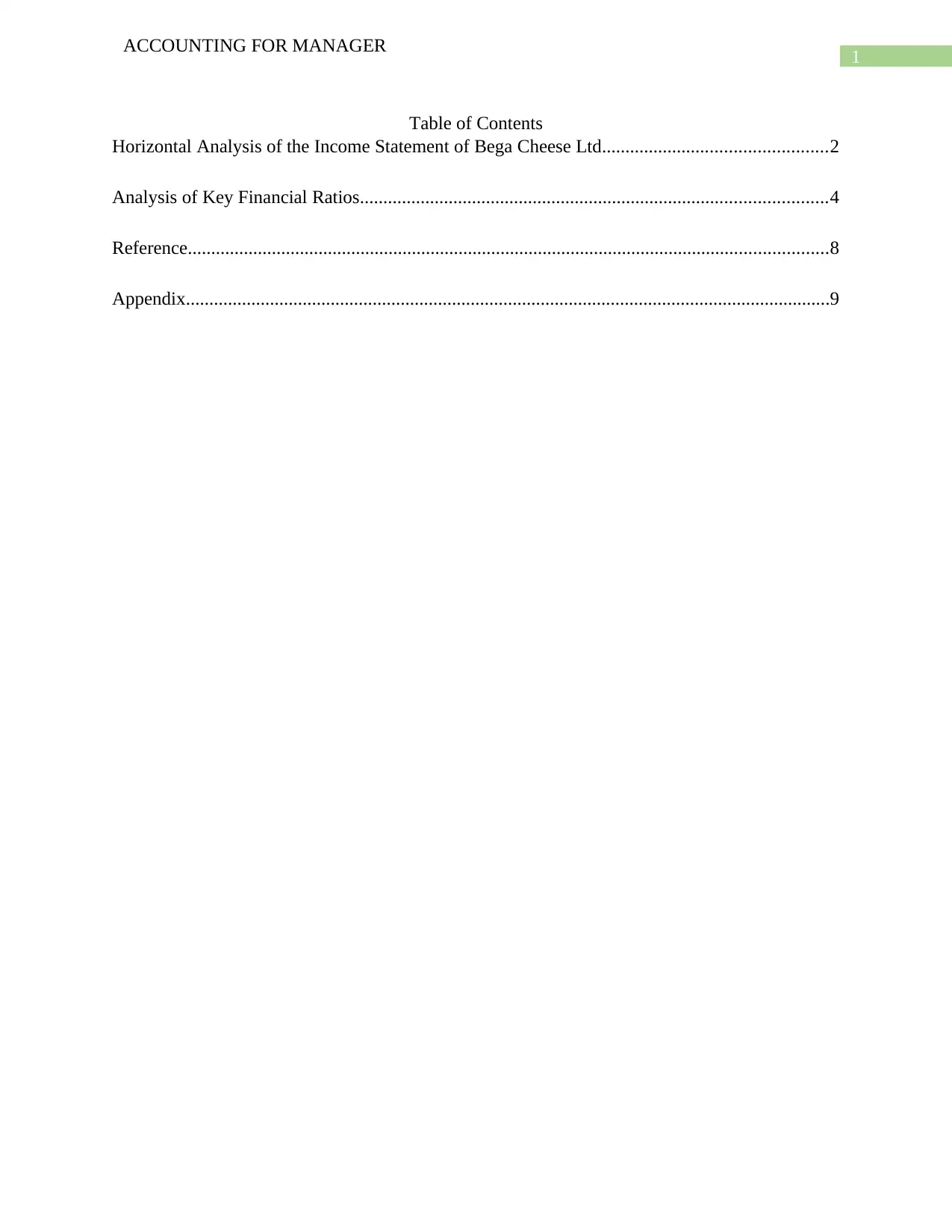
1
ACCOUNTING FOR MANAGER
Table of Contents
Horizontal Analysis of the Income Statement of Bega Cheese Ltd................................................2
Analysis of Key Financial Ratios....................................................................................................4
Reference.........................................................................................................................................8
Appendix..........................................................................................................................................9
ACCOUNTING FOR MANAGER
Table of Contents
Horizontal Analysis of the Income Statement of Bega Cheese Ltd................................................2
Analysis of Key Financial Ratios....................................................................................................4
Reference.........................................................................................................................................8
Appendix..........................................................................................................................................9
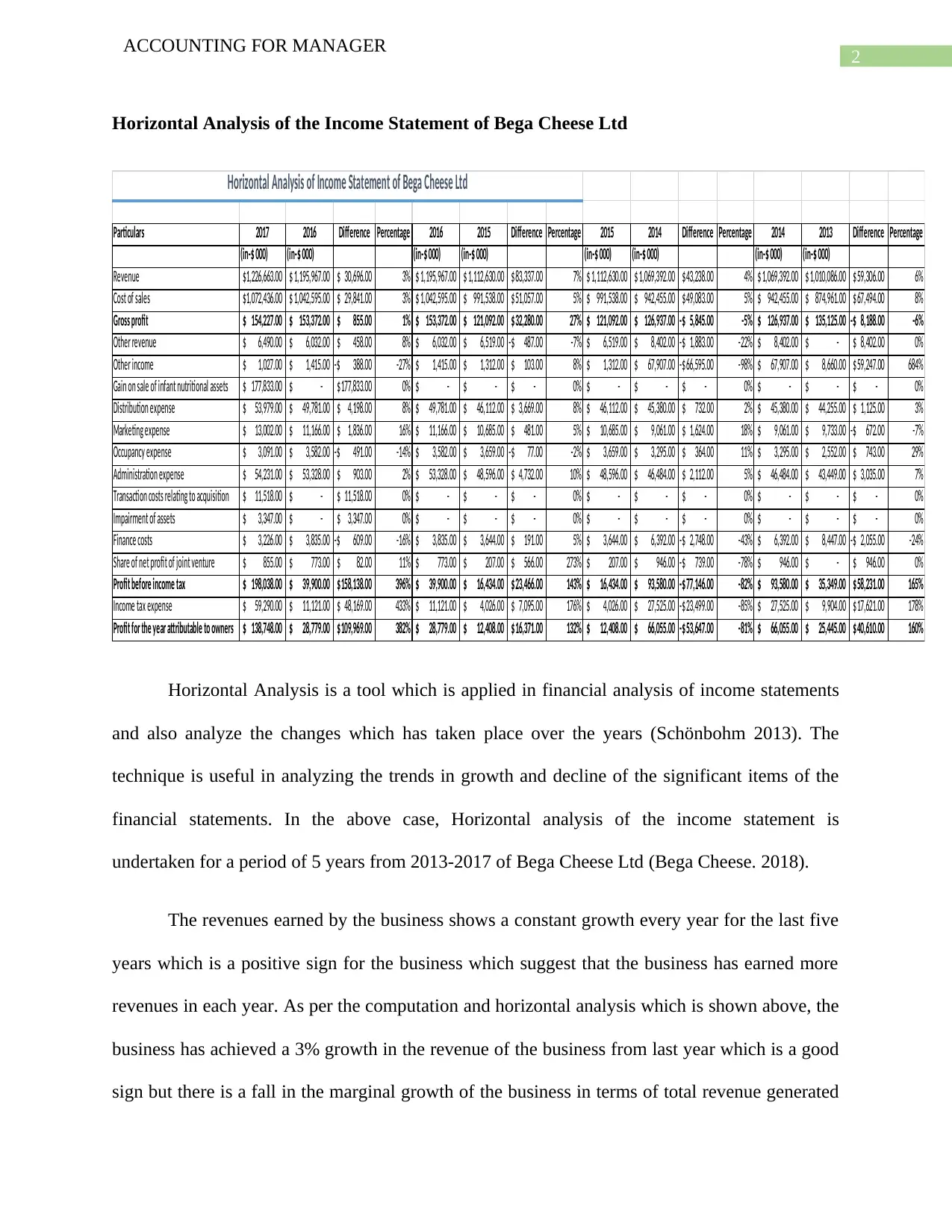
2
ACCOUNTING FOR MANAGER
Horizontal Analysis of the Income Statement of Bega Cheese Ltd
Particulars 2017 2016 Difference Percentage 2016 2015 Difference Percentage 2015 2014 Difference Percentage 2014 2013 Difference Percentage
(in-$ 000) (in-$ 000) (in-$ 000) (in-$ 000) (in-$ 000) (in-$ 000) (in-$ 000) (in-$ 000)
Revenue 1,226,663.00$ 1,195,967.00$ 30,696.00$ 3% 1,195,967.00$ 1,112,630.00$ 83,337.00$ 7% 1,112,630.00$ 1,069,392.00$ 43,238.00$ 4% 1,069,392.00$ 1,010,086.00$ 59,306.00$ 6%
Cost of sales 1,072,436.00$ 1,042,595.00$ 29,841.00$ 3% 1,042,595.00$ 991,538.00$ 51,057.00$ 5% 991,538.00$ 942,455.00$ 49,083.00$ 5% 942,455.00$ 874,961.00$ 67,494.00$ 8%
Gross profit 154,227.00$ 153,372.00$ 855.00$ 1% 153,372.00$ 121,092.00$ 32,280.00$ 27% 121,092.00$ 126,937.00$ 5,845.00-$ -5% 126,937.00$ 135,125.00$ 8,188.00-$ -6%
Other revenue 6,490.00$ 6,032.00$ 458.00$ 8% 6,032.00$ 6,519.00$ 487.00-$ -7% 6,519.00$ 8,402.00$ 1,883.00-$ -22% 8,402.00$ -$ 8,402.00$ 0%
Other income 1,027.00$ 1,415.00$ 388.00-$ -27% 1,415.00$ 1,312.00$ 103.00$ 8% 1,312.00$ 67,907.00$ 66,595.00-$ -98% 67,907.00$ 8,660.00$ 59,247.00$ 684%
Gain on sale of infant nutritional assets 177,833.00$ -$ 177,833.00$ 0% -$ -$ -$ 0% -$ -$ -$ 0% -$ -$ -$ 0%
Distribution expense 53,979.00$ 49,781.00$ 4,198.00$ 8% 49,781.00$ 46,112.00$ 3,669.00$ 8% 46,112.00$ 45,380.00$ 732.00$ 2% 45,380.00$ 44,255.00$ 1,125.00$ 3%
Marketing expense 13,002.00$ 11,166.00$ 1,836.00$ 16% 11,166.00$ 10,685.00$ 481.00$ 5% 10,685.00$ 9,061.00$ 1,624.00$ 18% 9,061.00$ 9,733.00$ 672.00-$ -7%
Occupancy expense 3,091.00$ 3,582.00$ 491.00-$ -14% 3,582.00$ 3,659.00$ 77.00-$ -2% 3,659.00$ 3,295.00$ 364.00$ 11% 3,295.00$ 2,552.00$ 743.00$ 29%
Administration expense 54,231.00$ 53,328.00$ 903.00$ 2% 53,328.00$ 48,596.00$ 4,732.00$ 10% 48,596.00$ 46,484.00$ 2,112.00$ 5% 46,484.00$ 43,449.00$ 3,035.00$ 7%
Transaction costs relating to acquisition 11,518.00$ -$ 11,518.00$ 0% -$ -$ -$ 0% -$ -$ -$ 0% -$ -$ -$ 0%
Impairment of assets 3,347.00$ -$ 3,347.00$ 0% -$ -$ -$ 0% -$ -$ -$ 0% -$ -$ -$ 0%
Finance costs 3,226.00$ 3,835.00$ 609.00-$ -16% 3,835.00$ 3,644.00$ 191.00$ 5% 3,644.00$ 6,392.00$ 2,748.00-$ -43% 6,392.00$ 8,447.00$ 2,055.00-$ -24%
Share of net profit of joint venture 855.00$ 773.00$ 82.00$ 11% 773.00$ 207.00$ 566.00$ 273% 207.00$ 946.00$ 739.00-$ -78% 946.00$ -$ 946.00$ 0%
Profit before income tax 198,038.00$ 39,900.00$ 158,138.00$ 396% 39,900.00$ 16,434.00$ 23,466.00$ 143% 16,434.00$ 93,580.00$ 77,146.00-$ -82% 93,580.00$ 35,349.00$ 58,231.00$ 165%
Income tax expense 59,290.00$ 11,121.00$ 48,169.00$ 433% 11,121.00$ 4,026.00$ 7,095.00$ 176% 4,026.00$ 27,525.00$ 23,499.00-$ -85% 27,525.00$ 9,904.00$ 17,621.00$ 178%
Profit for the year attributable to owners 138,748.00$ 28,779.00$ 109,969.00$ 382% 28,779.00$ 12,408.00$ 16,371.00$ 132% 12,408.00$ 66,055.00$ 53,647.00-$ -81% 66,055.00$ 25,445.00$ 40,610.00$ 160%
Horizontal Analysis of Income Statement of Bega Cheese Ltd
Horizontal Analysis is a tool which is applied in financial analysis of income statements
and also analyze the changes which has taken place over the years (Schönbohm 2013). The
technique is useful in analyzing the trends in growth and decline of the significant items of the
financial statements. In the above case, Horizontal analysis of the income statement is
undertaken for a period of 5 years from 2013-2017 of Bega Cheese Ltd (Bega Cheese. 2018).
The revenues earned by the business shows a constant growth every year for the last five
years which is a positive sign for the business which suggest that the business has earned more
revenues in each year. As per the computation and horizontal analysis which is shown above, the
business has achieved a 3% growth in the revenue of the business from last year which is a good
sign but there is a fall in the marginal growth of the business in terms of total revenue generated
ACCOUNTING FOR MANAGER
Horizontal Analysis of the Income Statement of Bega Cheese Ltd
Particulars 2017 2016 Difference Percentage 2016 2015 Difference Percentage 2015 2014 Difference Percentage 2014 2013 Difference Percentage
(in-$ 000) (in-$ 000) (in-$ 000) (in-$ 000) (in-$ 000) (in-$ 000) (in-$ 000) (in-$ 000)
Revenue 1,226,663.00$ 1,195,967.00$ 30,696.00$ 3% 1,195,967.00$ 1,112,630.00$ 83,337.00$ 7% 1,112,630.00$ 1,069,392.00$ 43,238.00$ 4% 1,069,392.00$ 1,010,086.00$ 59,306.00$ 6%
Cost of sales 1,072,436.00$ 1,042,595.00$ 29,841.00$ 3% 1,042,595.00$ 991,538.00$ 51,057.00$ 5% 991,538.00$ 942,455.00$ 49,083.00$ 5% 942,455.00$ 874,961.00$ 67,494.00$ 8%
Gross profit 154,227.00$ 153,372.00$ 855.00$ 1% 153,372.00$ 121,092.00$ 32,280.00$ 27% 121,092.00$ 126,937.00$ 5,845.00-$ -5% 126,937.00$ 135,125.00$ 8,188.00-$ -6%
Other revenue 6,490.00$ 6,032.00$ 458.00$ 8% 6,032.00$ 6,519.00$ 487.00-$ -7% 6,519.00$ 8,402.00$ 1,883.00-$ -22% 8,402.00$ -$ 8,402.00$ 0%
Other income 1,027.00$ 1,415.00$ 388.00-$ -27% 1,415.00$ 1,312.00$ 103.00$ 8% 1,312.00$ 67,907.00$ 66,595.00-$ -98% 67,907.00$ 8,660.00$ 59,247.00$ 684%
Gain on sale of infant nutritional assets 177,833.00$ -$ 177,833.00$ 0% -$ -$ -$ 0% -$ -$ -$ 0% -$ -$ -$ 0%
Distribution expense 53,979.00$ 49,781.00$ 4,198.00$ 8% 49,781.00$ 46,112.00$ 3,669.00$ 8% 46,112.00$ 45,380.00$ 732.00$ 2% 45,380.00$ 44,255.00$ 1,125.00$ 3%
Marketing expense 13,002.00$ 11,166.00$ 1,836.00$ 16% 11,166.00$ 10,685.00$ 481.00$ 5% 10,685.00$ 9,061.00$ 1,624.00$ 18% 9,061.00$ 9,733.00$ 672.00-$ -7%
Occupancy expense 3,091.00$ 3,582.00$ 491.00-$ -14% 3,582.00$ 3,659.00$ 77.00-$ -2% 3,659.00$ 3,295.00$ 364.00$ 11% 3,295.00$ 2,552.00$ 743.00$ 29%
Administration expense 54,231.00$ 53,328.00$ 903.00$ 2% 53,328.00$ 48,596.00$ 4,732.00$ 10% 48,596.00$ 46,484.00$ 2,112.00$ 5% 46,484.00$ 43,449.00$ 3,035.00$ 7%
Transaction costs relating to acquisition 11,518.00$ -$ 11,518.00$ 0% -$ -$ -$ 0% -$ -$ -$ 0% -$ -$ -$ 0%
Impairment of assets 3,347.00$ -$ 3,347.00$ 0% -$ -$ -$ 0% -$ -$ -$ 0% -$ -$ -$ 0%
Finance costs 3,226.00$ 3,835.00$ 609.00-$ -16% 3,835.00$ 3,644.00$ 191.00$ 5% 3,644.00$ 6,392.00$ 2,748.00-$ -43% 6,392.00$ 8,447.00$ 2,055.00-$ -24%
Share of net profit of joint venture 855.00$ 773.00$ 82.00$ 11% 773.00$ 207.00$ 566.00$ 273% 207.00$ 946.00$ 739.00-$ -78% 946.00$ -$ 946.00$ 0%
Profit before income tax 198,038.00$ 39,900.00$ 158,138.00$ 396% 39,900.00$ 16,434.00$ 23,466.00$ 143% 16,434.00$ 93,580.00$ 77,146.00-$ -82% 93,580.00$ 35,349.00$ 58,231.00$ 165%
Income tax expense 59,290.00$ 11,121.00$ 48,169.00$ 433% 11,121.00$ 4,026.00$ 7,095.00$ 176% 4,026.00$ 27,525.00$ 23,499.00-$ -85% 27,525.00$ 9,904.00$ 17,621.00$ 178%
Profit for the year attributable to owners 138,748.00$ 28,779.00$ 109,969.00$ 382% 28,779.00$ 12,408.00$ 16,371.00$ 132% 12,408.00$ 66,055.00$ 53,647.00-$ -81% 66,055.00$ 25,445.00$ 40,610.00$ 160%
Horizontal Analysis of Income Statement of Bega Cheese Ltd
Horizontal Analysis is a tool which is applied in financial analysis of income statements
and also analyze the changes which has taken place over the years (Schönbohm 2013). The
technique is useful in analyzing the trends in growth and decline of the significant items of the
financial statements. In the above case, Horizontal analysis of the income statement is
undertaken for a period of 5 years from 2013-2017 of Bega Cheese Ltd (Bega Cheese. 2018).
The revenues earned by the business shows a constant growth every year for the last five
years which is a positive sign for the business which suggest that the business has earned more
revenues in each year. As per the computation and horizontal analysis which is shown above, the
business has achieved a 3% growth in the revenue of the business from last year which is a good
sign but there is a fall in the marginal growth of the business in terms of total revenue generated
⊘ This is a preview!⊘
Do you want full access?
Subscribe today to unlock all pages.

Trusted by 1+ million students worldwide
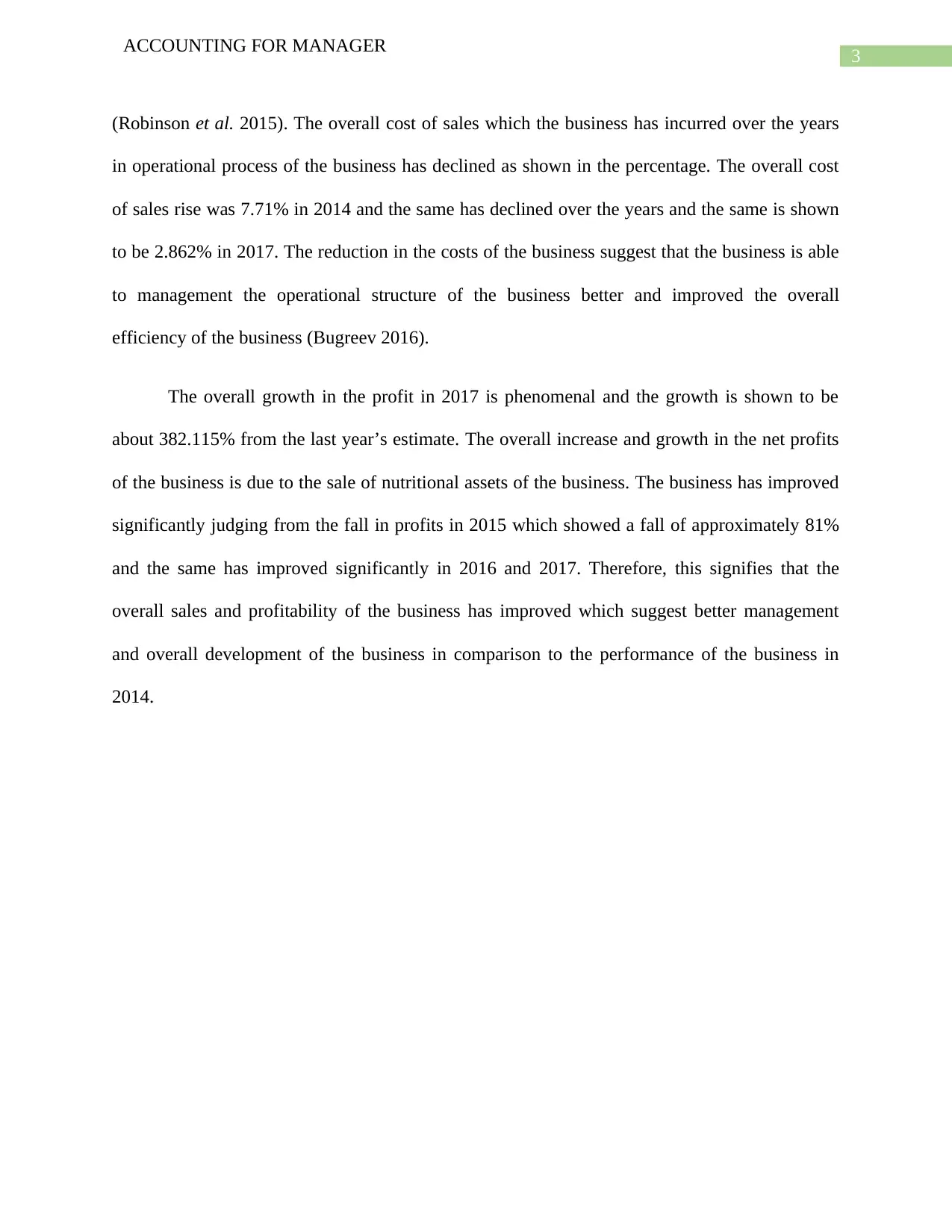
3
ACCOUNTING FOR MANAGER
(Robinson et al. 2015). The overall cost of sales which the business has incurred over the years
in operational process of the business has declined as shown in the percentage. The overall cost
of sales rise was 7.71% in 2014 and the same has declined over the years and the same is shown
to be 2.862% in 2017. The reduction in the costs of the business suggest that the business is able
to management the operational structure of the business better and improved the overall
efficiency of the business (Bugreev 2016).
The overall growth in the profit in 2017 is phenomenal and the growth is shown to be
about 382.115% from the last year’s estimate. The overall increase and growth in the net profits
of the business is due to the sale of nutritional assets of the business. The business has improved
significantly judging from the fall in profits in 2015 which showed a fall of approximately 81%
and the same has improved significantly in 2016 and 2017. Therefore, this signifies that the
overall sales and profitability of the business has improved which suggest better management
and overall development of the business in comparison to the performance of the business in
2014.
ACCOUNTING FOR MANAGER
(Robinson et al. 2015). The overall cost of sales which the business has incurred over the years
in operational process of the business has declined as shown in the percentage. The overall cost
of sales rise was 7.71% in 2014 and the same has declined over the years and the same is shown
to be 2.862% in 2017. The reduction in the costs of the business suggest that the business is able
to management the operational structure of the business better and improved the overall
efficiency of the business (Bugreev 2016).
The overall growth in the profit in 2017 is phenomenal and the growth is shown to be
about 382.115% from the last year’s estimate. The overall increase and growth in the net profits
of the business is due to the sale of nutritional assets of the business. The business has improved
significantly judging from the fall in profits in 2015 which showed a fall of approximately 81%
and the same has improved significantly in 2016 and 2017. Therefore, this signifies that the
overall sales and profitability of the business has improved which suggest better management
and overall development of the business in comparison to the performance of the business in
2014.
Paraphrase This Document
Need a fresh take? Get an instant paraphrase of this document with our AI Paraphraser
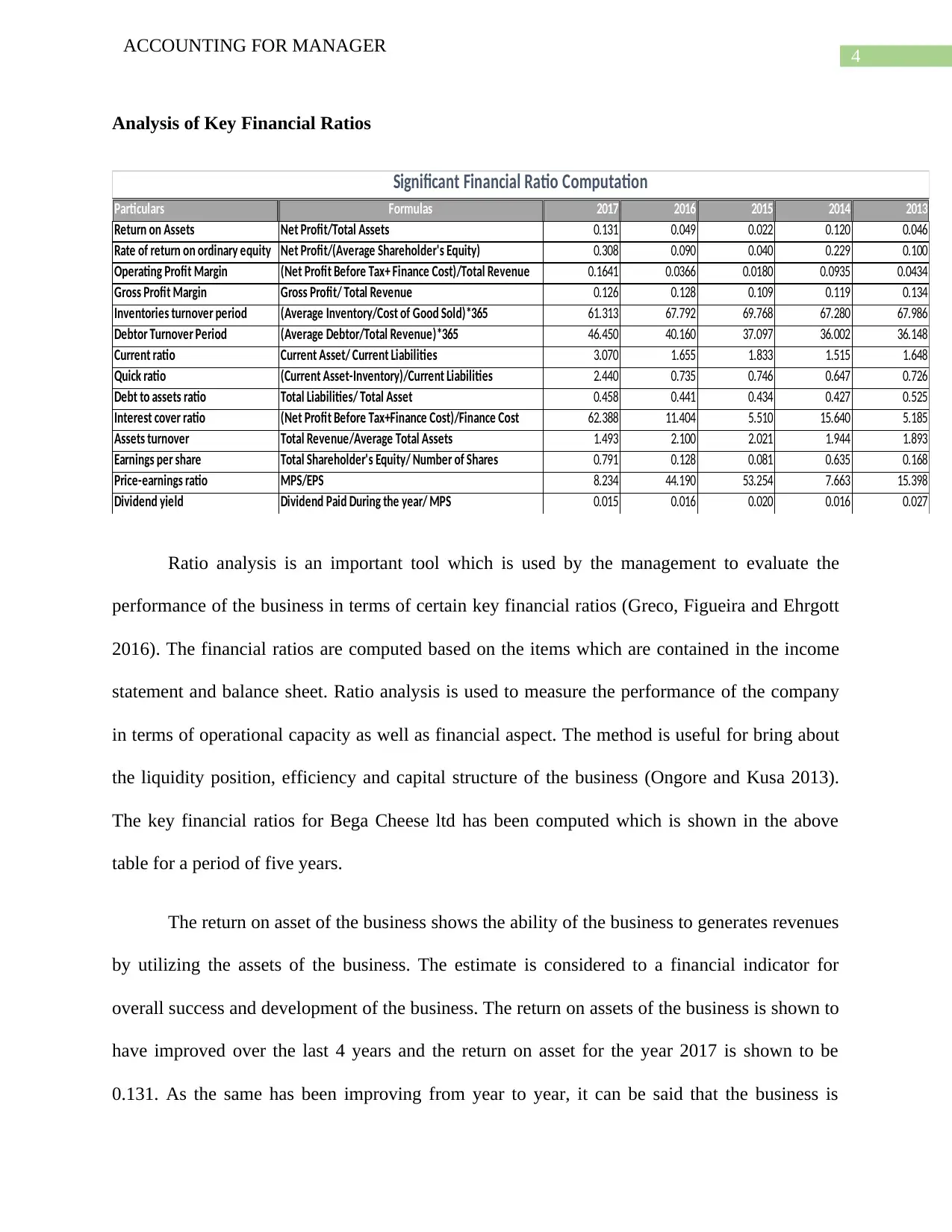
4
ACCOUNTING FOR MANAGER
Analysis of Key Financial Ratios
Particulars Formulas 2017 2016 2015 2014 2013
Return on Assets Net Profit/Total Assets 0.131 0.049 0.022 0.120 0.046
Rate of return on ordinary equity Net Profit/(Average Shareholder's Equity) 0.308 0.090 0.040 0.229 0.100
Operating Profit Margin (Net Profit Before Tax+ Finance Cost)/Total Revenue 0.1641 0.0366 0.0180 0.0935 0.0434
Gross Profit Margin Gross Profit/ Total Revenue 0.126 0.128 0.109 0.119 0.134
Inventories turnover period (Average Inventory/Cost of Good Sold)*365 61.313 67.792 69.768 67.280 67.986
Debtor Turnover Period (Average Debtor/Total Revenue)*365 46.450 40.160 37.097 36.002 36.148
Current ratio Current Asset/ Current Liabilities 3.070 1.655 1.833 1.515 1.648
Quick ratio (Current Asset-Inventory)/Current Liabilities 2.440 0.735 0.746 0.647 0.726
Debt to assets ratio Total Liabilities/ Total Asset 0.458 0.441 0.434 0.427 0.525
Interest cover ratio (Net Profit Before Tax+Finance Cost)/Finance Cost 62.388 11.404 5.510 15.640 5.185
Assets turnover Total Revenue/Average Total Assets 1.493 2.100 2.021 1.944 1.893
Earnings per share Total Shareholder's Equity/ Number of Shares 0.791 0.128 0.081 0.635 0.168
Price-earnings ratio MPS/EPS 8.234 44.190 53.254 7.663 15.398
Dividend yield Dividend Paid During the year/ MPS 0.015 0.016 0.020 0.016 0.027
Significant Financial Ratio Computation
Ratio analysis is an important tool which is used by the management to evaluate the
performance of the business in terms of certain key financial ratios (Greco, Figueira and Ehrgott
2016). The financial ratios are computed based on the items which are contained in the income
statement and balance sheet. Ratio analysis is used to measure the performance of the company
in terms of operational capacity as well as financial aspect. The method is useful for bring about
the liquidity position, efficiency and capital structure of the business (Ongore and Kusa 2013).
The key financial ratios for Bega Cheese ltd has been computed which is shown in the above
table for a period of five years.
The return on asset of the business shows the ability of the business to generates revenues
by utilizing the assets of the business. The estimate is considered to a financial indicator for
overall success and development of the business. The return on assets of the business is shown to
have improved over the last 4 years and the return on asset for the year 2017 is shown to be
0.131. As the same has been improving from year to year, it can be said that the business is
ACCOUNTING FOR MANAGER
Analysis of Key Financial Ratios
Particulars Formulas 2017 2016 2015 2014 2013
Return on Assets Net Profit/Total Assets 0.131 0.049 0.022 0.120 0.046
Rate of return on ordinary equity Net Profit/(Average Shareholder's Equity) 0.308 0.090 0.040 0.229 0.100
Operating Profit Margin (Net Profit Before Tax+ Finance Cost)/Total Revenue 0.1641 0.0366 0.0180 0.0935 0.0434
Gross Profit Margin Gross Profit/ Total Revenue 0.126 0.128 0.109 0.119 0.134
Inventories turnover period (Average Inventory/Cost of Good Sold)*365 61.313 67.792 69.768 67.280 67.986
Debtor Turnover Period (Average Debtor/Total Revenue)*365 46.450 40.160 37.097 36.002 36.148
Current ratio Current Asset/ Current Liabilities 3.070 1.655 1.833 1.515 1.648
Quick ratio (Current Asset-Inventory)/Current Liabilities 2.440 0.735 0.746 0.647 0.726
Debt to assets ratio Total Liabilities/ Total Asset 0.458 0.441 0.434 0.427 0.525
Interest cover ratio (Net Profit Before Tax+Finance Cost)/Finance Cost 62.388 11.404 5.510 15.640 5.185
Assets turnover Total Revenue/Average Total Assets 1.493 2.100 2.021 1.944 1.893
Earnings per share Total Shareholder's Equity/ Number of Shares 0.791 0.128 0.081 0.635 0.168
Price-earnings ratio MPS/EPS 8.234 44.190 53.254 7.663 15.398
Dividend yield Dividend Paid During the year/ MPS 0.015 0.016 0.020 0.016 0.027
Significant Financial Ratio Computation
Ratio analysis is an important tool which is used by the management to evaluate the
performance of the business in terms of certain key financial ratios (Greco, Figueira and Ehrgott
2016). The financial ratios are computed based on the items which are contained in the income
statement and balance sheet. Ratio analysis is used to measure the performance of the company
in terms of operational capacity as well as financial aspect. The method is useful for bring about
the liquidity position, efficiency and capital structure of the business (Ongore and Kusa 2013).
The key financial ratios for Bega Cheese ltd has been computed which is shown in the above
table for a period of five years.
The return on asset of the business shows the ability of the business to generates revenues
by utilizing the assets of the business. The estimate is considered to a financial indicator for
overall success and development of the business. The return on assets of the business is shown to
have improved over the last 4 years and the return on asset for the year 2017 is shown to be
0.131. As the same has been improving from year to year, it can be said that the business is
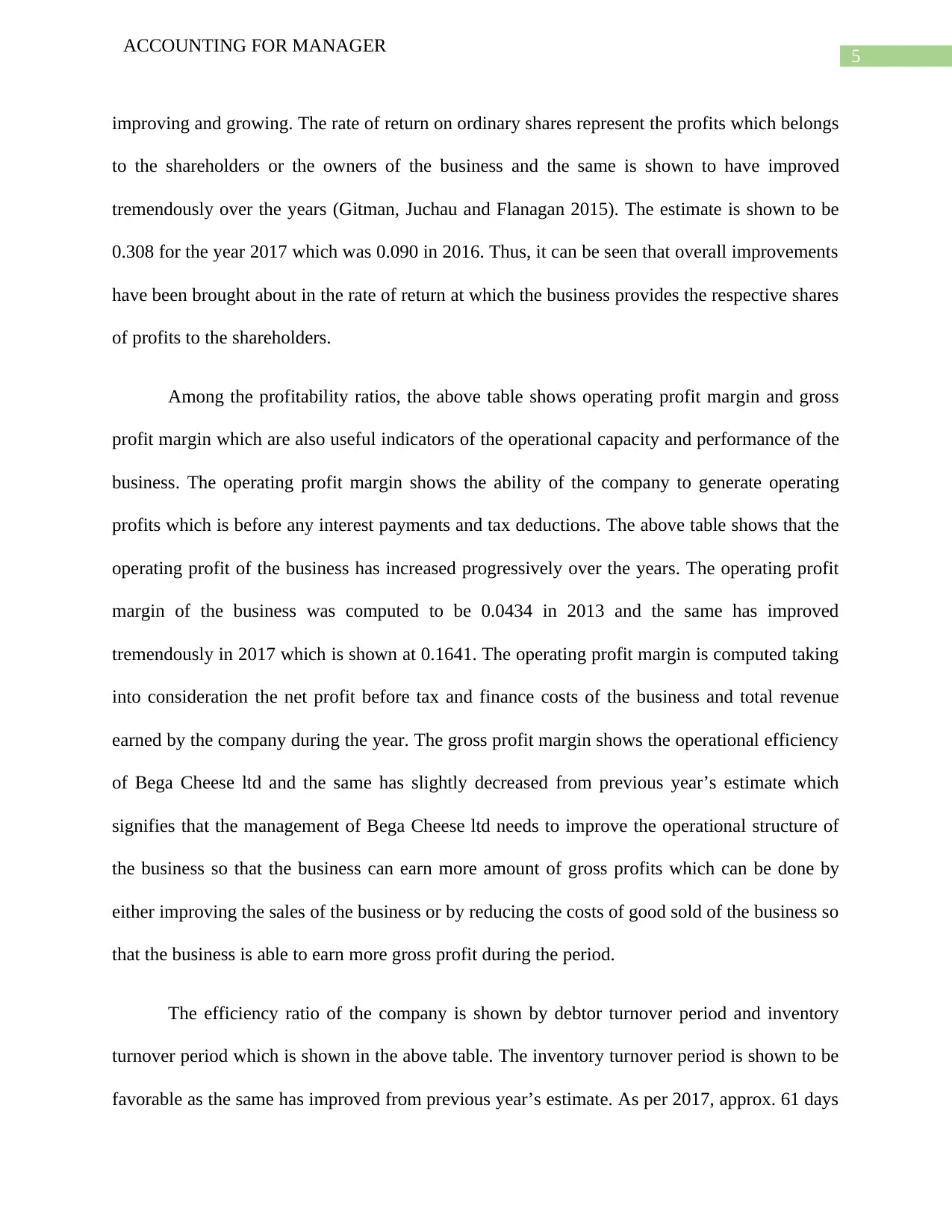
5
ACCOUNTING FOR MANAGER
improving and growing. The rate of return on ordinary shares represent the profits which belongs
to the shareholders or the owners of the business and the same is shown to have improved
tremendously over the years (Gitman, Juchau and Flanagan 2015). The estimate is shown to be
0.308 for the year 2017 which was 0.090 in 2016. Thus, it can be seen that overall improvements
have been brought about in the rate of return at which the business provides the respective shares
of profits to the shareholders.
Among the profitability ratios, the above table shows operating profit margin and gross
profit margin which are also useful indicators of the operational capacity and performance of the
business. The operating profit margin shows the ability of the company to generate operating
profits which is before any interest payments and tax deductions. The above table shows that the
operating profit of the business has increased progressively over the years. The operating profit
margin of the business was computed to be 0.0434 in 2013 and the same has improved
tremendously in 2017 which is shown at 0.1641. The operating profit margin is computed taking
into consideration the net profit before tax and finance costs of the business and total revenue
earned by the company during the year. The gross profit margin shows the operational efficiency
of Bega Cheese ltd and the same has slightly decreased from previous year’s estimate which
signifies that the management of Bega Cheese ltd needs to improve the operational structure of
the business so that the business can earn more amount of gross profits which can be done by
either improving the sales of the business or by reducing the costs of good sold of the business so
that the business is able to earn more gross profit during the period.
The efficiency ratio of the company is shown by debtor turnover period and inventory
turnover period which is shown in the above table. The inventory turnover period is shown to be
favorable as the same has improved from previous year’s estimate. As per 2017, approx. 61 days
ACCOUNTING FOR MANAGER
improving and growing. The rate of return on ordinary shares represent the profits which belongs
to the shareholders or the owners of the business and the same is shown to have improved
tremendously over the years (Gitman, Juchau and Flanagan 2015). The estimate is shown to be
0.308 for the year 2017 which was 0.090 in 2016. Thus, it can be seen that overall improvements
have been brought about in the rate of return at which the business provides the respective shares
of profits to the shareholders.
Among the profitability ratios, the above table shows operating profit margin and gross
profit margin which are also useful indicators of the operational capacity and performance of the
business. The operating profit margin shows the ability of the company to generate operating
profits which is before any interest payments and tax deductions. The above table shows that the
operating profit of the business has increased progressively over the years. The operating profit
margin of the business was computed to be 0.0434 in 2013 and the same has improved
tremendously in 2017 which is shown at 0.1641. The operating profit margin is computed taking
into consideration the net profit before tax and finance costs of the business and total revenue
earned by the company during the year. The gross profit margin shows the operational efficiency
of Bega Cheese ltd and the same has slightly decreased from previous year’s estimate which
signifies that the management of Bega Cheese ltd needs to improve the operational structure of
the business so that the business can earn more amount of gross profits which can be done by
either improving the sales of the business or by reducing the costs of good sold of the business so
that the business is able to earn more gross profit during the period.
The efficiency ratio of the company is shown by debtor turnover period and inventory
turnover period which is shown in the above table. The inventory turnover period is shown to be
favorable as the same has improved from previous year’s estimate. As per 2017, approx. 61 days
⊘ This is a preview!⊘
Do you want full access?
Subscribe today to unlock all pages.

Trusted by 1+ million students worldwide
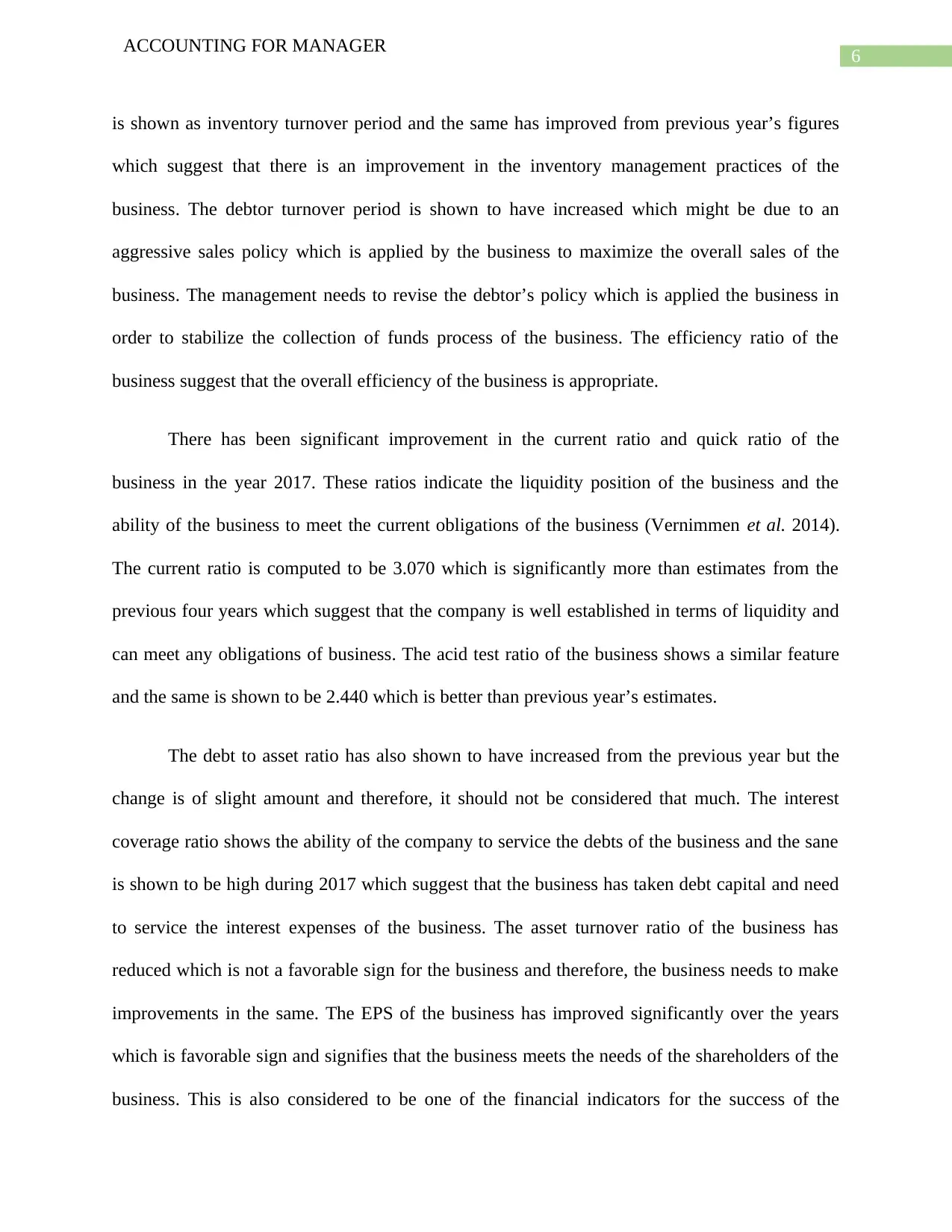
6
ACCOUNTING FOR MANAGER
is shown as inventory turnover period and the same has improved from previous year’s figures
which suggest that there is an improvement in the inventory management practices of the
business. The debtor turnover period is shown to have increased which might be due to an
aggressive sales policy which is applied by the business to maximize the overall sales of the
business. The management needs to revise the debtor’s policy which is applied the business in
order to stabilize the collection of funds process of the business. The efficiency ratio of the
business suggest that the overall efficiency of the business is appropriate.
There has been significant improvement in the current ratio and quick ratio of the
business in the year 2017. These ratios indicate the liquidity position of the business and the
ability of the business to meet the current obligations of the business (Vernimmen et al. 2014).
The current ratio is computed to be 3.070 which is significantly more than estimates from the
previous four years which suggest that the company is well established in terms of liquidity and
can meet any obligations of business. The acid test ratio of the business shows a similar feature
and the same is shown to be 2.440 which is better than previous year’s estimates.
The debt to asset ratio has also shown to have increased from the previous year but the
change is of slight amount and therefore, it should not be considered that much. The interest
coverage ratio shows the ability of the company to service the debts of the business and the sane
is shown to be high during 2017 which suggest that the business has taken debt capital and need
to service the interest expenses of the business. The asset turnover ratio of the business has
reduced which is not a favorable sign for the business and therefore, the business needs to make
improvements in the same. The EPS of the business has improved significantly over the years
which is favorable sign and signifies that the business meets the needs of the shareholders of the
business. This is also considered to be one of the financial indicators for the success of the
ACCOUNTING FOR MANAGER
is shown as inventory turnover period and the same has improved from previous year’s figures
which suggest that there is an improvement in the inventory management practices of the
business. The debtor turnover period is shown to have increased which might be due to an
aggressive sales policy which is applied by the business to maximize the overall sales of the
business. The management needs to revise the debtor’s policy which is applied the business in
order to stabilize the collection of funds process of the business. The efficiency ratio of the
business suggest that the overall efficiency of the business is appropriate.
There has been significant improvement in the current ratio and quick ratio of the
business in the year 2017. These ratios indicate the liquidity position of the business and the
ability of the business to meet the current obligations of the business (Vernimmen et al. 2014).
The current ratio is computed to be 3.070 which is significantly more than estimates from the
previous four years which suggest that the company is well established in terms of liquidity and
can meet any obligations of business. The acid test ratio of the business shows a similar feature
and the same is shown to be 2.440 which is better than previous year’s estimates.
The debt to asset ratio has also shown to have increased from the previous year but the
change is of slight amount and therefore, it should not be considered that much. The interest
coverage ratio shows the ability of the company to service the debts of the business and the sane
is shown to be high during 2017 which suggest that the business has taken debt capital and need
to service the interest expenses of the business. The asset turnover ratio of the business has
reduced which is not a favorable sign for the business and therefore, the business needs to make
improvements in the same. The EPS of the business has improved significantly over the years
which is favorable sign and signifies that the business meets the needs of the shareholders of the
business. This is also considered to be one of the financial indicators for the success of the
Paraphrase This Document
Need a fresh take? Get an instant paraphrase of this document with our AI Paraphraser

7
ACCOUNTING FOR MANAGER
business and one of the estimates which is considered by the potentials investors before they take
any appropriate investment decisions.
Reference
Bega Cheese. (2018). Annual Reports - Bega Cheese. [online] Available at:
https://www.begacheese.com.au/investors/annual-reports/ [Accessed 28 Jul. 2018].
Bugreev, D.O., 2016. Financial analysis of small business enterprises. Contemporary Problems
of Social Work, 2(1), pp.28-35.
Gitman, L.J., Juchau, R. and Flanagan, J., 2015. Principles of managerial finance. Pearson
Higher Education AU.
Greco, S., Figueira, J. and Ehrgott, M., 2016. Multiple criteria decision analysis. New York:
Springer.
Ongore, V.O. and Kusa, G.B., 2013. Determinants of financial performance of commercial banks
in Kenya. International Journal of Economics and Financial Issues, 3(1), pp.237-252.
ACCOUNTING FOR MANAGER
business and one of the estimates which is considered by the potentials investors before they take
any appropriate investment decisions.
Reference
Bega Cheese. (2018). Annual Reports - Bega Cheese. [online] Available at:
https://www.begacheese.com.au/investors/annual-reports/ [Accessed 28 Jul. 2018].
Bugreev, D.O., 2016. Financial analysis of small business enterprises. Contemporary Problems
of Social Work, 2(1), pp.28-35.
Gitman, L.J., Juchau, R. and Flanagan, J., 2015. Principles of managerial finance. Pearson
Higher Education AU.
Greco, S., Figueira, J. and Ehrgott, M., 2016. Multiple criteria decision analysis. New York:
Springer.
Ongore, V.O. and Kusa, G.B., 2013. Determinants of financial performance of commercial banks
in Kenya. International Journal of Economics and Financial Issues, 3(1), pp.237-252.

8
ACCOUNTING FOR MANAGER
Robinson, T.R., Henry, E., Pirie, W.L. and Broihahn, M.A., 2015. International financial
statement analysis. John Wiley & Sons.
Schönbohm, A., 2013. Performance measurement and management with financial ratios: the
BASF SE case (No. 72). Working Papers of the Institute of Management Berlin at the Berlin
School of Economics and Law (HWR Berlin).
Vernimmen, P., Quiry, P., Dallocchio, M., Le Fur, Y. and Salvi, A., 2014. Corporate finance:
theory and practice. John Wiley & Sons.
Weygandt, J.J., Kimmel, P.D. and Kieso, D.E., 2015. Financial & managerial accounting. John
Wiley & Sons.
ACCOUNTING FOR MANAGER
Robinson, T.R., Henry, E., Pirie, W.L. and Broihahn, M.A., 2015. International financial
statement analysis. John Wiley & Sons.
Schönbohm, A., 2013. Performance measurement and management with financial ratios: the
BASF SE case (No. 72). Working Papers of the Institute of Management Berlin at the Berlin
School of Economics and Law (HWR Berlin).
Vernimmen, P., Quiry, P., Dallocchio, M., Le Fur, Y. and Salvi, A., 2014. Corporate finance:
theory and practice. John Wiley & Sons.
Weygandt, J.J., Kimmel, P.D. and Kieso, D.E., 2015. Financial & managerial accounting. John
Wiley & Sons.
⊘ This is a preview!⊘
Do you want full access?
Subscribe today to unlock all pages.

Trusted by 1+ million students worldwide
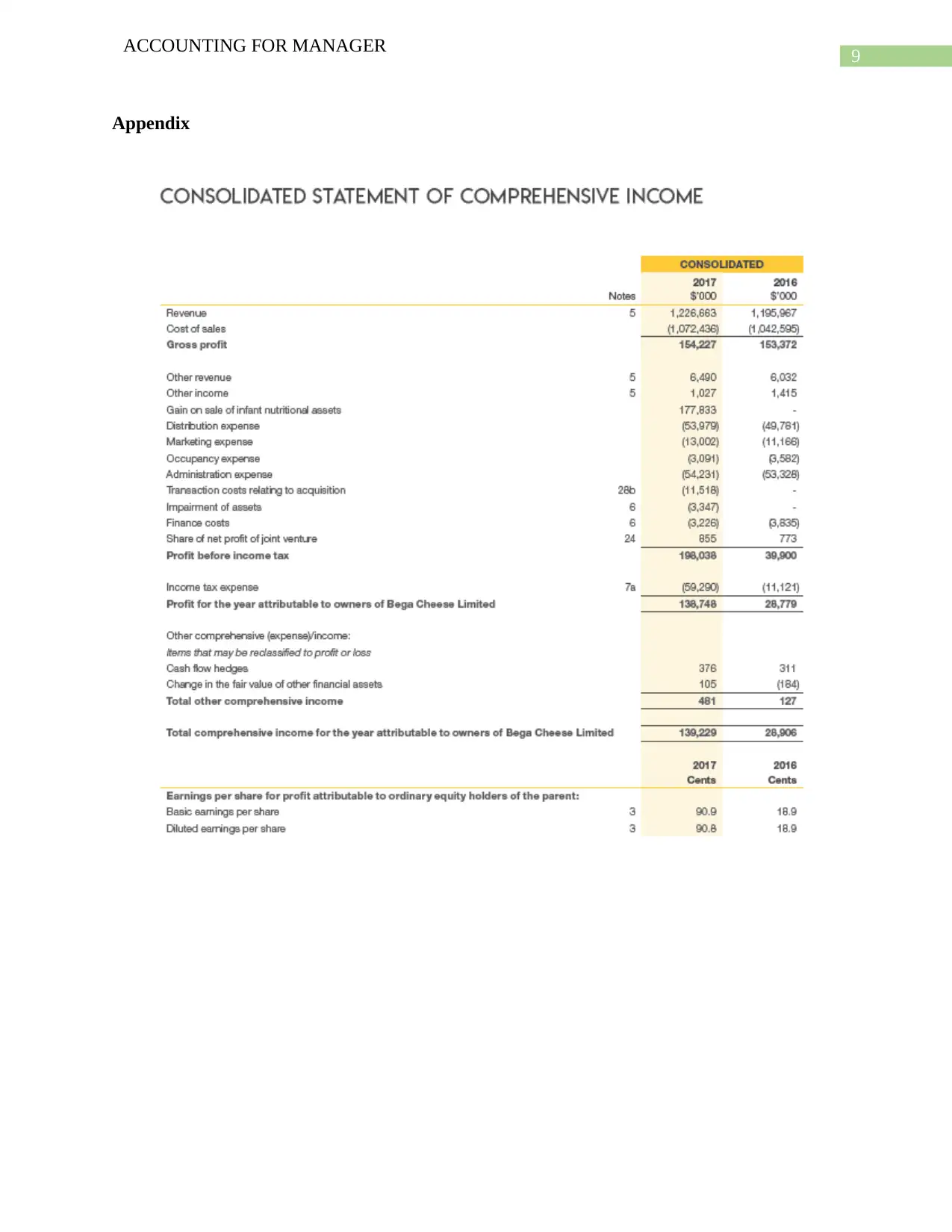
9
ACCOUNTING FOR MANAGER
Appendix
ACCOUNTING FOR MANAGER
Appendix
Paraphrase This Document
Need a fresh take? Get an instant paraphrase of this document with our AI Paraphraser

10
ACCOUNTING FOR MANAGER
ACCOUNTING FOR MANAGER
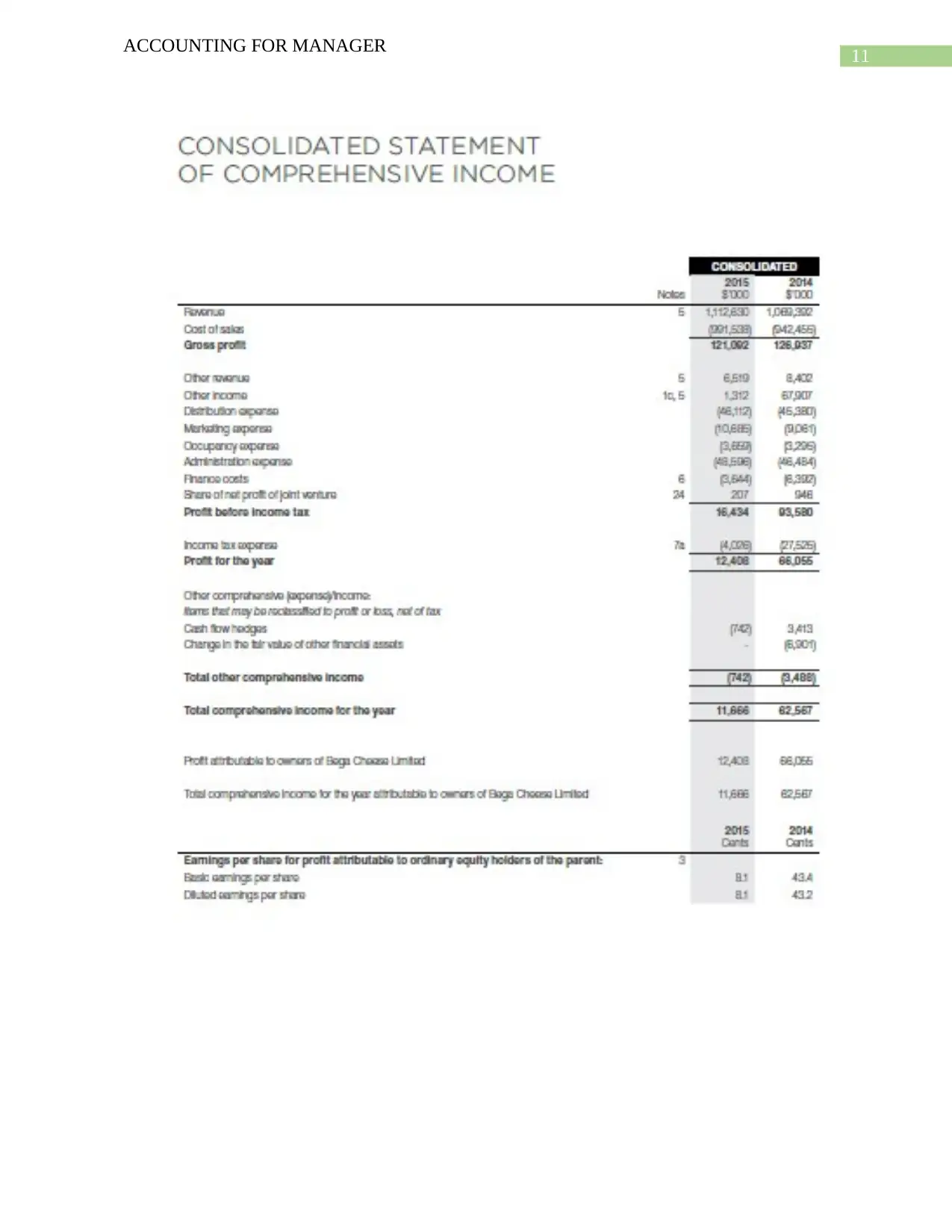
11
ACCOUNTING FOR MANAGER
ACCOUNTING FOR MANAGER
⊘ This is a preview!⊘
Do you want full access?
Subscribe today to unlock all pages.

Trusted by 1+ million students worldwide
1 out of 15
Related Documents
Your All-in-One AI-Powered Toolkit for Academic Success.
+13062052269
info@desklib.com
Available 24*7 on WhatsApp / Email
![[object Object]](/_next/static/media/star-bottom.7253800d.svg)
Unlock your academic potential
Copyright © 2020–2025 A2Z Services. All Rights Reserved. Developed and managed by ZUCOL.



